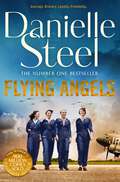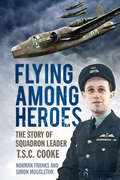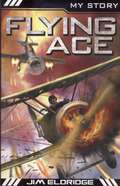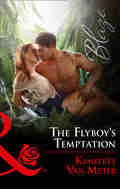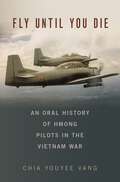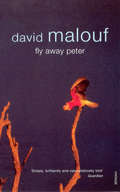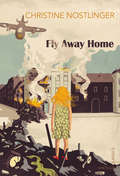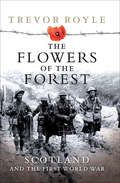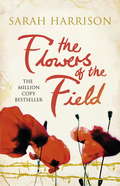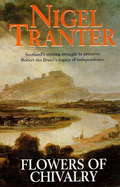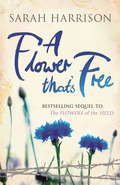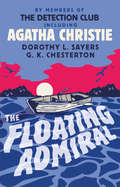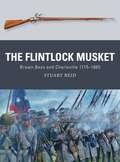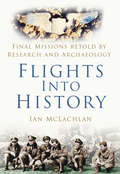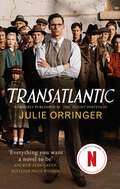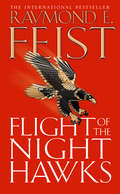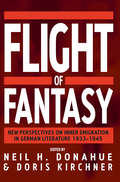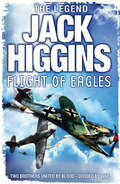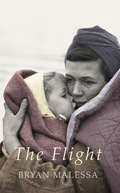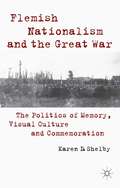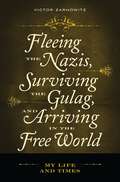- Table View
- List View
Flying Angels
by Danielle SteelFlying Angels is a compelling and inspirational story of women of courage in the Second World War, by the world’s number one bestselling author, Danielle Steel.It is 1941 and the devastating loss of life following the Japanese attack on Pearl Harbor leaves best friends Audrey and Lizzie distraught and bereft as they lose someone they both love deeply. As they come to terms with their grief, their resolve to play a worthwhile role towards the war effort is strengthened. As trained nurses they volunteer for the army medivac corps and are sent to England where they join a team who fly on dangerous missions to the Front to bring back wounded soldiers.Audrey, Lizzie and their fellow medics and pilots will suffer the tragedies of war and experience loss and suffering. They will come to understand the importance of friendship, respect, bravery and being true to yourself. But, once the war is over, can they learn one of the hardest lessons of all: the ability to love again?
Flying Among Heroes: The Story of Squadron Leader T.S.C. Cooke
by Norman Franks Simon MuggletonT.S.C. Cooke joined the RAF as war began in 1939, aged 18, and trained to be a bomber pilot. Rising to the rank of squadron leader and decorated three times, Cooke bombed Berlin on 7 October 1940 in a Whitley Mk V, nearly ditching in the North Sea. Throughout this tour he faced the usual dangers of wartime aircrew, his aircraft being hit by AA fire on several occasions, once almost having to order his aircrew to bail out but landed safely at the last minute. They were also attacked by night fighters, encountered icing and even shot up a train and bomber station at tree-top level. Flying Wellingtons and Stirlings, Cooke took part in the infamous 1,000-bomber raid on Cologne and Essen, before returning to operations flying Special Ops Halifax aircraft, dropping agents into enemy-occupied France. After a dozen missions, he was shot down but he and his navigator survived and evaded capture. Helped by the French resistance, they got into Spain and returned home via Gibraltar. Both men received the DFC for their bravery. While their story is not totally unique, their adventures and courage make this tale akin to an adventure novel.
Flying Ace (PDF)
by Jim EldridgeJack Fairfax is the 19-year-old second son of Lord and Lady Fairfax. The Fairfaxes are steeped in the military tradition, and don't approve of Jack's volunteering for the Royal Flying Corps. New-fangled flying machines are nothing to do with 'proper' warfare. Nevertheless, Jack takes to the skies in his Bleriot plane, and faces the skills of the German ace pilots over the Somme. When his best friend is shot down by one of them, he vows to avenge him. . .
The Flyboy's Temptation: Daring Her Seal Come Closer, Cowboy Big Sky Seduction The Flyboy's Temptation (Mills And Boon Blaze Ser.)
by Kimberly Van MeterRisky business… A redhead with long legs, creamy kissable skin, and a big fat wad of cash? That's the kind of trouble former Air Force pilot J.T. Carmichael can't resist.
Fly Until You Die: An Oral History of Hmong Pilots in the Vietnam War (Oxford Oral History Series)
by Chia Youyee VangDuring the Vietnam War, the US Air Force secretly trained pilots from Laos, skirting Lao neutrality in order to bolster the Royal Lao Air Force and their own war efforts. Beginning in 1964, this covert project, "Water Pump," operated out of Udorn Airbase in Thailand with the support of the CIA. This Secret War required recruits from Vietnam-border region willing to take great risks--a demand that was met by the marginalized Hmong ethnic minority. Soon, dozens of Hmong men were training at Water Pump and providing air support to the US-sponsored clandestine army in Laos. Short and problematic training that resulted in varied skill levels, ground fire, dangerous topography, bad weather conditions, and poor aircraft quality, however, led to a nearly 50 percent casualty rate, and those pilots who survived mostly sought refuge in the United States after the war. Drawing from numerous oral history interviews, Fly Until You Die brings their stories to light for the first time--in the words of those who lived it.
Fly Until You Die: An Oral History of Hmong Pilots in the Vietnam War (Oxford Oral History Series)
by Chia Youyee VangDuring the Vietnam War, the US Air Force secretly trained pilots from Laos, skirting Lao neutrality in order to bolster the Royal Lao Air Force and their own war efforts. Beginning in 1964, this covert project, "Water Pump," operated out of Udorn Airbase in Thailand with the support of the CIA. This Secret War required recruits from Vietnam-border region willing to take great risks--a demand that was met by the marginalized Hmong ethnic minority. Soon, dozens of Hmong men were training at Water Pump and providing air support to the US-sponsored clandestine army in Laos. Short and problematic training that resulted in varied skill levels, ground fire, dangerous topography, bad weather conditions, and poor aircraft quality, however, led to a nearly 50 percent casualty rate, and those pilots who survived mostly sought refuge in the United States after the war. Drawing from numerous oral history interviews, Fly Until You Die brings their stories to light for the first time--in the words of those who lived it.
Fly Away Peter (Vintage International Series)
by David MaloufFor three very different people brought together by their love for birds, life on the Queensland coast in 1914 is the timeless and idyllic world of sandpipers, ibises and kingfishers. In another hemisphere civilization rushes headlong into a brutal conflict. Life there is lived from moment to moment. Inevitably, the two young men - sanctuary owner and employee - are drawn to the war, and into the mud and horror of the trenches of Armentieres. Alone on the beach, their friend Imogen, the middle-aged wildlife photographer, must acknowledge for all three of them that the past cannot be held.
Fly Away Home
by Christine Nostlinger'The story I'm going to tell is true. It happened to me. It is a tale of Gunpowdertown’Life for Cristal has been upside down for a long time. She can’t even remember a time before the war began. Before potatoes for every meal and bombs raining down from the sky. Before being forced to shelter in the dark, damp cellars. Then one day, Cristal’s home is turned into a pile of rubble and dust five metres high.But a chance offer saves her family. They move to the safety of a wealthy suburb, camping out amongst the chandeliers and family portraits of someone else’s house. That is until the dreaded Russians roll into Vienna and move in too…Includes exclusive material: In the Backstory you can test your knowledge of the book, and learn more about the Second World War Vintage Children’s Classics is a twenty-first century classics list aimed at 8-12 year olds and the adults in their lives. Discover timeless favourites from The Jungle Book and Alice’s Adventures in Wonderland to modern classics such as The Boy in the Striped Pyjamas and The Curious Incident of the Dog in the Night-Time.
The Flowers of the Forest: Scotland and the First World War
by Trevor RoyleTrevor Royle has done First World War History a great service' - Gary Sheffield 'Graphic, ably controlled...the power of imaginative storytelling is Royle's endeavour' - The Guardian 'His exceptional talents at narration produce a work that is both through-provoking and engaging. This is a vivid, solidly-written book, drawing upon the best in recent scholarship' - International Review of Scottish Studies On the brink of the First World War, Scotland was regarded throughout the British Isles as 'the workshop of the Empire'. Not only were Clyde-built ships known the world over, Scotland produced half of Britain's total production of railway equipment, and the cotton and jute industries flourished in Paisley and Dundee. In addition, Scots were a hugely important source of manpower for the colonies. Yet after the war, Scotland became an industrial and financial backwater. Emigration increased as morale slumped in the face of economic stagnation and decline. The country had paid a disproportionately high price in casualties, a result of huge numbers of volunteers and the use of Scottish battalions as shock troops in the fighting on the Western Front and Gallipoli - young men whom the novelist Ian Hay called 'the vanished generation'. In this book, Trevor Royle provides the first full account of how the war changed Scotland irrevocably by exploring a wide range of themes - the overwhelming response to the call for volunteers; the performance of Scottish military formations in 1915 and 1916; the militarisation of the Scottish homeland; the resistance to war in Glasgow and the west of Scotland; the boom in the heavy industries and the strengthening of women's role in society following on from wartime employment.
The Flowers of the Field: The international bestseller
by Sarah HarrisonThe million copy internationally bestselling novel of one family and the devastating effects of the First World War. 'Loved the book...a very moving and powerful read which had me in tears more than once. An easy 5 stars.' Goodreads reviewer, 5 stars'Sarah Harrison shows herself to be more than equal to the complexities of her plot, handling its developments with impeccable timing' The TimesThea Tennant, eldest daughter of a wealthy industrialist father and beautiful aristocratic mother, yearns to do more than follow the traditional path laid out for her. When her beautiful but flighty sister Dulcie brings trouble to the family, both Thea and Dulcie are sent to relatives in Austria. But with the onset of War, their lives change beyond recognition. It isn't just the Tennants whose lives have changed: for their parlourmaid, Primmy, the War brings opportunities she is determined to take.From the Kent countryside to the suffragette movement in London and the horrors of the Western Front, THE FLOWERS OF THE FIELD is an epic novel of the dreams and aspirations of a generation who found a voice above history's most horrifying conflict.Readers love this dramatic and emotional wartime epic:'for curling up on the sofa and getting totally and utterly lost in.' Amazon reviewer'absorbing and gripping' Amazon reviewer 'Unbelievably good book' Amazon reviewer 'A work of extraordinary fictional daring...assured...always convinces' Weekend Telegraph
Flowers of Chivalry (Coronet Bks.)
by Nigel TranterOnce again Scotland was fighting for her survival as a free andindependent nation.Robert the Bruce's legacy, three years after his death in 1329, is indanger. With a five-year-old heir guarded by an ageing and diminishingband of lieutenants, the English King, Edward III, has seen hisopportunity. War is renewed, a puppet king set up.In the years of struggle that follow, two men stand out as leaders oftheir people: Sir William Douglas, the Knight of Liddesdale, known asthe Flower of Chivalry; and Sir Alexander Ramsay of Dalwolsey.Friends and comrades-in-arms by their gallantry and daring, they do morethan any others to save their country.Yet something is to happen between them that will cause one of the mostdesperate events in Scotland's violent and dramatic history...
A Flower That's Free: The bestselling sequel to The Flowers of the Field
by Sarah HarrisonSequel to the international bestseller, THE FLOWERS OF THE FIELD, this is an epic novel set amid the turbulence of the Second World War.'This is the second in the trilogy and, like the first, I cannot put it down. Sarah Harrison is such a good writer' Amazon reviewer, 5 starsKate Kingsley remembers little of her early childhood, other than the devastation of being torn away from everything she knew in France and sent to live as the adopted daughter of Jack and Thea in Kenya.Now 20, she leaves for a new life in London. But this is 1936 - a time of decadence, but also turmoil.Kate finds an unexpected ally in her Aunt Dulcie, whose own life is anything but straightforward. When Kate falls in love she believes she has found a soul mate. But this is just the start of a journey during which Kate confronts personal danger, faces conflicting loyalties, and must make a heart-breaking choice.'Harrison is a writer with a gift for mixing candour [and] compassion' You magazine
The Floating Admiral (The\detection Club Ser.)
by Agatha Christie by Members The Detection ClubAgatha Christie, Dorothy L. Sayers, G.K. Chesterton and nine other writers from the legendary Detection Club collaborate in this fiendishly clever but forgotten crime novel first published 80 years ago.
The Flintlock Musket: Brown Bess and Charleville 1715–1865 (Weapon #44)
by Steve Noon Stuart Reid Alan GillilandThe flintlock or firelock musket is one of the most iconic weapons in history: used on the battlefields of the English Civil War, it was then carried by both sides at Blenheim, Bunker Hill, Waterloo and the Alamo, and dominated warfare for more than 150 years, with military service as late as the American Civil War in the 1860s. Featuring specially commissioned full-colour artwork, this engaging study examines the role that the flintlock played in close-order combat on European and other battlefields around the world. Employing first-hand accounts to show how tactical doctrines were successfully developed to overcome the weapon's inherent limitations, Stuart Reid offers a comprehensive analysis of the flintlock's lasting impact as the first truly universal soldier's weapon.
The Flintlock Musket: Brown Bess and Charleville 1715–1865 (Weapon #44)
by Stuart Reid Alan Gilliland Mr Steve NoonThe flintlock or firelock musket is one of the most iconic weapons in history: used on the battlefields of the English Civil War, it was then carried by both sides at Blenheim, Bunker Hill, Waterloo and the Alamo, and dominated warfare for more than 150 years, with military service as late as the American Civil War in the 1860s. Featuring specially commissioned full-colour artwork, this engaging study examines the role that the flintlock played in close-order combat on European and other battlefields around the world. Employing first-hand accounts to show how tactical doctrines were successfully developed to overcome the weapon's inherent limitations, Stuart Reid offers a comprehensive analysis of the flintlock's lasting impact as the first truly universal soldier's weapon.
Flights Into History: Final Missions Retold by Research and Archaeology (History Press Ser.)
by Ian McLachlanIn this compelling sequel to Final Flights, aviation archaeologist Ian McLachlan has reconstructed the dramatic last flights of Second World War airmen, including the first Fortress to fall in combat from the USAAF's 447th Bomber Group; the final flight of an intruder Mosquito pursuing a German night fighter; the courage of a Lancaster pilot responsible for six lives aboard a burning aircraft; the story of a Spitfire's last flight and its heroic Belgian pilot. Exciting stories are also recounted of those whose misdirected courage saw them serve under the swastika. In reconstructing long-forgotten wartime events, often from buried wreckage, eyewitness accounts and contemporary documentation, aviation archaeologists can bring recognition to the individual flyers involved and shed new light on the air war over Britain and Europe during the Second World War. Even the discovery of small fragments can be significant. They provide evidence or prompt new research, revealing stories that offer a uniquely human dimension and reveal the hopes, fears, aspirations and pleasures of the aircrew involved. Ian McLachlan and other aviation archaeologists have now done them justice.
The Flight Portfolio: Based on a true story, utterly gripping and heartbreaking World War 2 historical fiction
by Julie Orringer1940, Nazi occupied France. In the middle of a devastating war, how many lives can you save?Varian Fry, a young American journalist, arrives in Marseille, shortly after the Germans have occupied the country. He is armed only with three thousand dollars and a list of writers, thinkers and artists he hopes to rescue - so long as the Nazis don't get to them first.With borders closing around him, Varian tries to track down those on his list - renowned artists like Marc Chagall, who cannot believe that he will ever be unsafe in the country he loves. He smuggles them over the Pyrenees mountains and across the sea hidden in boats, but everyday hundreds of ordinary Jewish refugees beg him for help. Does Varian have the right to choose who to save?At home in New York, making a list seemed simple, but in the middle of the worst war imaginable, he must do all he can to help. And as the Nazis begin to get word of Varian's secret operation, he must find dig deep and find the courage to rescue as many innocents as he can.Even though his own life may be in terrible danger. An incredibly compelling and heart-wrenching historical novel, inspired by true events, about the extraordinary courage and friendships forged during humanity's darkest hour. If you loved Schindler's List, All The Light We Cannot See or The Tattooist of Auschwitz, you'll adore The Flight Portfolio.What readers are saying about The Flight Portfolio:⭐⭐⭐⭐⭐ 'Oh - it's FABULOUS!... The best historical novel I've read in a long time.' Goodreads Reviewer⭐⭐⭐⭐⭐ 'I love this book so much I can barely breathe.' Goodreads Reviewer⭐⭐⭐⭐⭐ 'Such a wonderful novel!!... Please do yourself a favour and read it!!' Goodreads Reviewer⭐⭐⭐⭐⭐ 'Couldn't put this down. Beautiful writing and a riveting plot make this book an absolute page-turner!' Goodreads Reviewer⭐⭐⭐⭐⭐ 'I did not want this book to end... Riveting. I loved it.' Goodreads Reviewer⭐⭐⭐⭐⭐ 'An outstanding book for anyone who likes historical fiction, a gripping story, lyrical writing, or all three. It is one of those books that you never want to end.' Goodreads Reviewer⭐⭐⭐⭐⭐ 'I can't begin to believe that I will read another book this year that will even come close to reaching the heights of The Flight Portfolio.' Goodreads Reviewer
Flight of the Night Hawks: Flight Of The Night Hawks, Into A Dark Realm, Wrath Of A Mad God (Darkwar #1)
by Raymond E. FeistThe whole of the magnificent Riftwar Cycle by bestselling author Raymond E. Feist, master of magic and adventure, now available in ebook
Flight of Fantasy: New Perspectives on Inner Emigration in German Literature 1933-1945
by Neil H. Donahue Doris KirchnerDuring the Nazi era many German writers chose, or were forced into, exile. Many others stayed and, after the end of this period, claimed to have retreated into "Inner Emigration". The nature of this kind of emigration and the underlying motives of these writers have been hotly debated to this day. Though the reception of Inner Emigration has often been confounded by disputes over the term itself, the issue is ultimately not a matter of nomenclature, but of more far-reaching issues of literary evaluation, moral discernment and the writing of history. This volume presents, for the first time, to an English-speaking readership the complexity of Inner Emigration through the analysis of problematic individual cases of writers who, under constant pressure from a watchful dictatorship to conform and to collaborate, were caught between conscience and compromise.
Flight of Eagles (Dougal Munro/jack Carter Ser. #3)
by Jack HigginsBorn in the United States but separated since they were boys, twin brothers Max and Harry Kelso found themselves fighting on opposite sides when the Second World War broke out, Max as one of the Luftwaffe’s most feared pilots, Harry as a Yank ace in the RAF…
The Flight
by Bryan MalessaA powerful novel set at the end of World War II about one woman and her family's struggle for survival.
Flemish Nationalism and the Great War: The Politics of Memory, Visual Culture and Commemoration
by K. ShelbyKaren Shelby addresses the IJzertoren Memorial, which is dedicated to the Flemish dead of the Great War, and the role the monument has played in the discussions among the various political, social and cultural ideologies of the Flemish community.
The Fleet Air Arm in the Second World War, Volume II, 1942-1943: The Fleet Air Arm in Transition – the Mediterranean, Battle of the Atlantic and the Indian Ocean (Navy Records Society Publications)
by Ben JonesThis is the second of three volumes covering the transformation of the Fleet Air Arm during the Second World War. As the subtitle of this volume ‘The Fleet Air Arm in Transition’ suggests, the years 1942-1943 marked a stepping stone between the small pre-war cadre operating from a small number of carriers to a naval air arm flying modern aircraft types from a large number of ships and as will be seen in Volume III capable of operating a number of Fleet Carriers in the Pacific Ocean for sustained periods. Whereas the majority of Volume I dealt with operations, this volume has a much more even balance covering planning and policy on the one hand and operations on the other. This reflects the crucial nature of this period as the development and expansion of the Fleet Air Arm gathered pace, whilst an increasingly diverse range of operations took place with those in the Mediterranean and the Atlantic reaching a climax. The reader will gain a clear appreciation of the growing importance, indeed primacy, of the aircraft carrier within the proposals for the future composition of Royal Navy’s surface fleet together with the nature of the Fleet Air Arm’s expansion programmes. Such expansion programmes were hindered by the constraints of aircraft production and the acquisition of sufficient shore facilities for the formation of new squadrons and the continued support of others. Some of the Fleet Air Arm’s most famous operations occurred during these years such as the escort of the ‘Pedestal’ convoy to Malta, air cover for the landings in North Africa, Sicily and at Salerno and the gallant, but ill-fated attack of 825 Squadron during the Channel Dash. The increasing role played by the Fleet Air Arm aircraft operating from Escort Carriers and Merchant Aircraft Carriers in the Battle of the Atlantic during 1943 is also apparent. The documents in this volume will bring to life the difficulties of operating aircraft at sea, the nature of air combat and the complexities involved in expanding an organisation such as the Fleet Air Arm under wartime conditions. As such it will enhance our understanding of the history of the Royal Navy’s air arm during the Second World War.
The Fleet Air Arm in the Second World War, Volume II, 1942-1943: The Fleet Air Arm in Transition – the Mediterranean, Battle of the Atlantic and the Indian Ocean (Navy Records Society Publications)
by Ben Jones M. Phil.This is the second of three volumes covering the transformation of the Fleet Air Arm during the Second World War. As the subtitle of this volume ‘The Fleet Air Arm in Transition’ suggests, the years 1942-1943 marked a stepping stone between the small pre-war cadre operating from a small number of carriers to a naval air arm flying modern aircraft types from a large number of ships and as will be seen in Volume III capable of operating a number of Fleet Carriers in the Pacific Ocean for sustained periods. Whereas the majority of Volume I dealt with operations, this volume has a much more even balance covering planning and policy on the one hand and operations on the other. This reflects the crucial nature of this period as the development and expansion of the Fleet Air Arm gathered pace, whilst an increasingly diverse range of operations took place with those in the Mediterranean and the Atlantic reaching a climax. The reader will gain a clear appreciation of the growing importance, indeed primacy, of the aircraft carrier within the proposals for the future composition of Royal Navy’s surface fleet together with the nature of the Fleet Air Arm’s expansion programmes. Such expansion programmes were hindered by the constraints of aircraft production and the acquisition of sufficient shore facilities for the formation of new squadrons and the continued support of others. Some of the Fleet Air Arm’s most famous operations occurred during these years such as the escort of the ‘Pedestal’ convoy to Malta, air cover for the landings in North Africa, Sicily and at Salerno and the gallant, but ill-fated attack of 825 Squadron during the Channel Dash. The increasing role played by the Fleet Air Arm aircraft operating from Escort Carriers and Merchant Aircraft Carriers in the Battle of the Atlantic during 1943 is also apparent. The documents in this volume will bring to life the difficulties of operating aircraft at sea, the nature of air combat and the complexities involved in expanding an organisation such as the Fleet Air Arm under wartime conditions. As such it will enhance our understanding of the history of the Royal Navy’s air arm during the Second World War.
Fleeing the Nazis, Surviving the Gulag, and Arriving in the Free World: My Life and Times (Non-ser.)
by Victor ZarnowitzVictor Zarnowitz is a world-famous economist. Victor Zarnowitz is also a man who grew up in the Polish town of Oswiecim, known in German as Auschwitz. Zarnowitz and his brother fled the area as the Nazis advanced in September 1939. Moving eastward, he landed right in the arms of the Soviets and was sent to a Siberian Gulag. How did this brilliant young man, who nearly died at the hands of the Soviets, end up a renowned University of Chicago economist? That's exactly what this inspiring, lyrical memoir—told in simple, captivating prose—is all about.The recipient of many prizes and honors, Zarnowitz is still, at age eighty-seven, one of the six economists who decide officially that the U.S. is in a recession. He is also a captivating writer and his memoir a thrilling page turner: -In September 1939 Victor and his brother walked the entire width of Poland with the blitzkrieg just behind them. They ran right into oncoming Soviet troops. Zarnowitz was trapped at the junction of the two most fearsome armies the world had ever seen. He was literally standing in the center point of history.-The Soviets considered Polish refugees prisoners of war. In 1940, they transported Zarnowitz and his brother thousands of miles north and put them to work in Stalin's oldest Gulag. They earned their daily gruel and bread crusts by trying to meet impossible work quotas.The last third of the book brings the story up to date, telling, in a non-technical manner, of Zarnowitz's life in America and his professional career. It includes his observations of other economists and their ideas, his own contributions to business-cycle theory and economic indicators, and his thoughts on more than a half-century of American history.While memoirs of the Holocaust are plentiful, the Jewish experience in Stalin's Gulags has been virtually forgotten. Weaving politics and economics into the harrowing tale of his personal journey, Zarnowitz's inspiring life story provides a priceless perspective on some of the most traumatic upheavals of the 20th century—and on the resilience and power of the human spirit.
